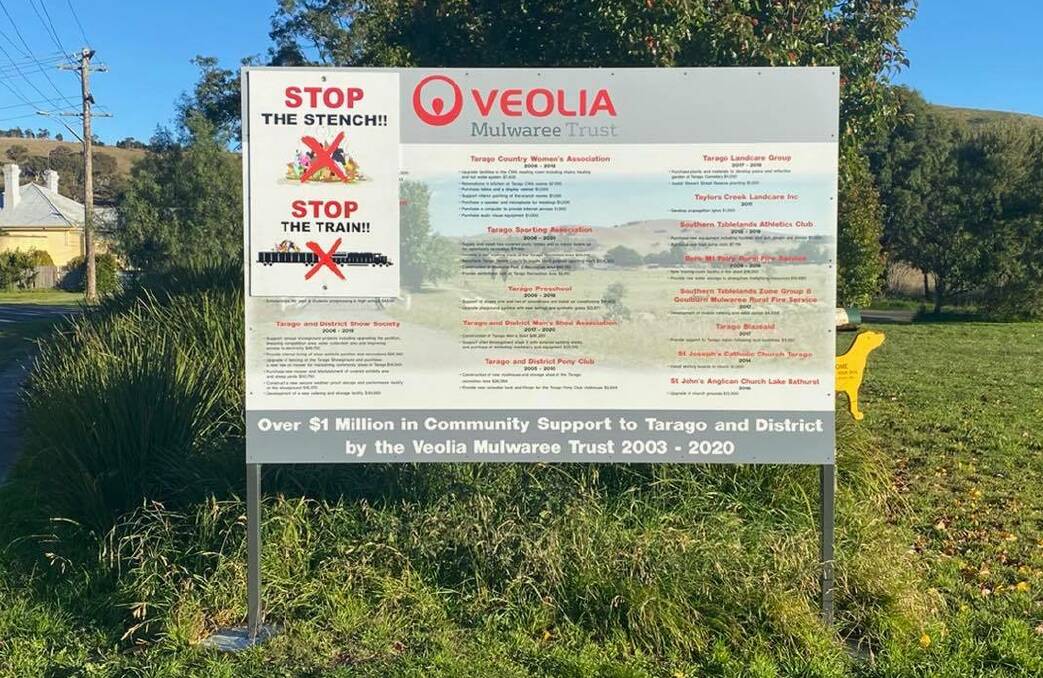
Sally Bopping's dream finally came true when she purchased acreage in Tarago. However, decades of hard work was soon soured by a foul odour from the Woodlawn bioreactor.
Subscribe now for unlimited access.
or signup to continue reading
For more than 14 years Tarago residents have complained of a bad smell coming from the Veolia operated facility.
This morning, residents woke to protest signs saying 'stop the stench' and 'stop the train' plastered around town.
Ms Bopping said it smelt like "rotten egg, sulfur and dead animal".
"Imagine my horror when I first smelt it, you can almost taste it.
"Sometimes, I sit outside and try to have a barbecue but it smells so bad I retch."
READ ALSO:
The bioreactor receives just over one million tonnes of putrescible waste annually, to generate electricity by harnessing the methane gas created by decomposition.
People have reported the odour from as far afield as Gundaroo, Mount Fairy, Collector and Lower Boro.
One resident told the Goulburn Post they lived 12km, as the crow flies, from the Woodlawn site and were impacted by the odour.
While they had occasionally smelt the mine over the past six years, recently it had become "so putrid we have to remain indoors".
Ms Bopping said residents experienced issues when they hung washing outside to dry. She said the "putrid stench" embedded itself into clothes and sheets.
Many people have submitted complaints to the Environmental Protection Agency (EPA) via 'odour logs' supplied by the government organisation.
Ms Bopping said the each log contained six rows to record six different incidents, but the EPA only recorded them as one complaint.
A spokesperson from the EPA said they had received more than 100 complaints this year, with the majority in the last month.
"Complaints have been received from a range of locations, with the majority within a 15km vicinity of the Tarago township," they said.
"The EPA has been actively liaising with the operator of the Veolia Woodlawn reactor and believes the cause of the current spike in odours has been identified.
"As a result the EPA has directed Veolia to address odour emissions with additional gas monitoring, the installation of additional gas collection equipment and covering odour emission points with biofiltration material."
The spokesperson said a longer term infrastructure program was in the final stages of being commissioned which would contribute to odour management.
Ms Bopping said residents held concerns about a "lack of community consultation", and the level of bio-aerosols in the air.
A Veolia spokesperson said the business worked closely with the EPA and took a "proactive and transparent approach to the management of odour".
"We minimise odour by sealing the waste daily, then capturing and extracting over 4000 cubic metres of gas from the landfill every hour, and use it to produce electricity.
"We have increased the frequency of our sampling and are investing in additional infrastructure and process improvements to allow greater capture of biogas, which will further minimise odour."
An independent odour audit, an annual requirement, found landfill gas samples at the site were primarily composted of methane (50.7 per cent, odourless), carbon dioxide (47.2 per cent, odourless), hydrogen sulphide (around one per cent, rotten-egg smell) and other trace gases (less than one per cent).
The EPA encouraged anyone affected by the odour to contact the Enviro Line on 131 555.
Our journalists work hard to provide local, up-to-date news to the community. This is how you can access our trusted content:
- Bookmark our website
- Follow us on Twitter
- Follow us on Google News
- Make sure you are signed up for our breaking news and regular newsletters

